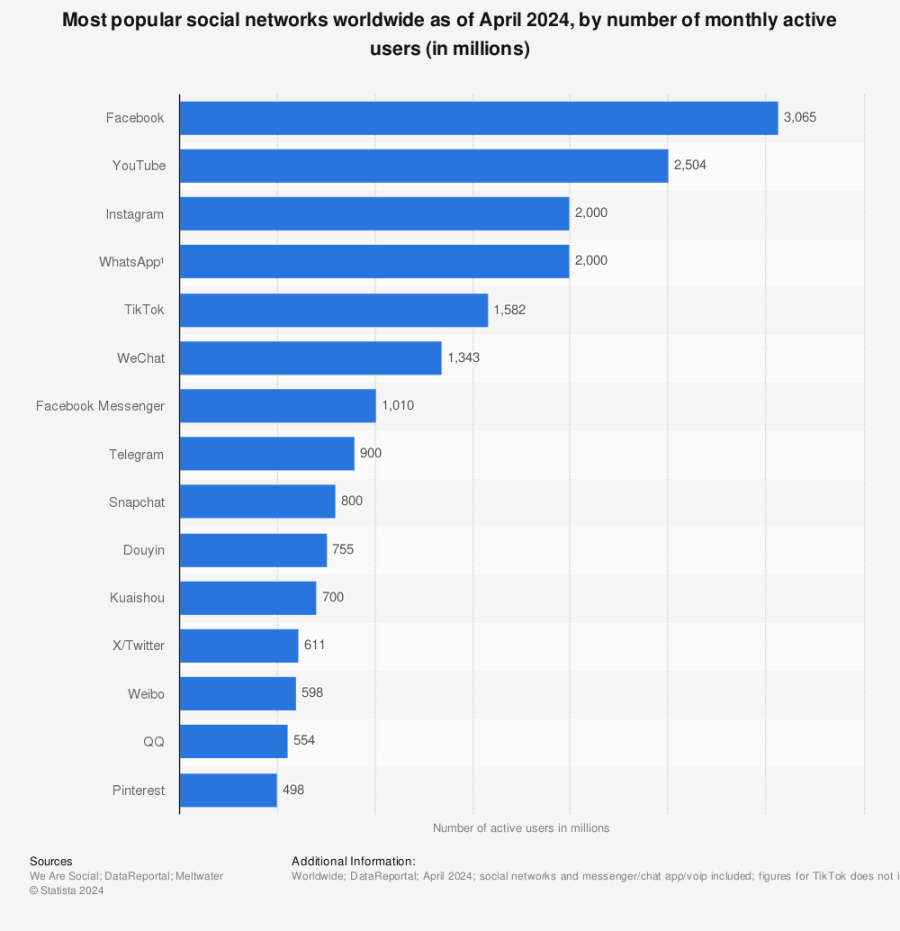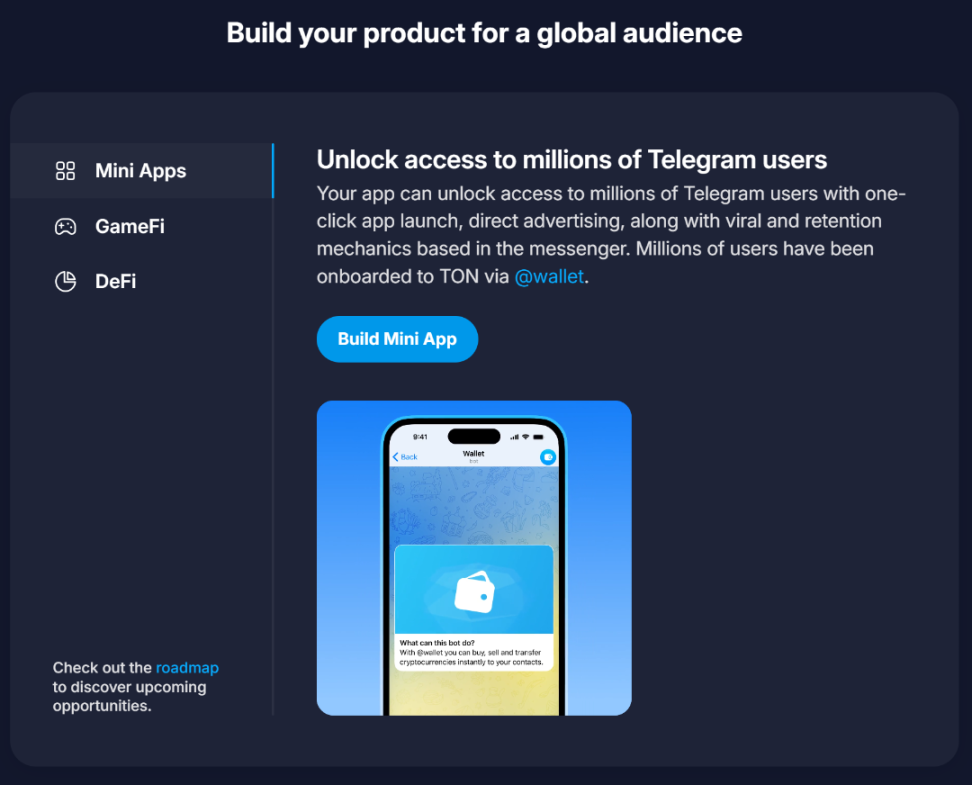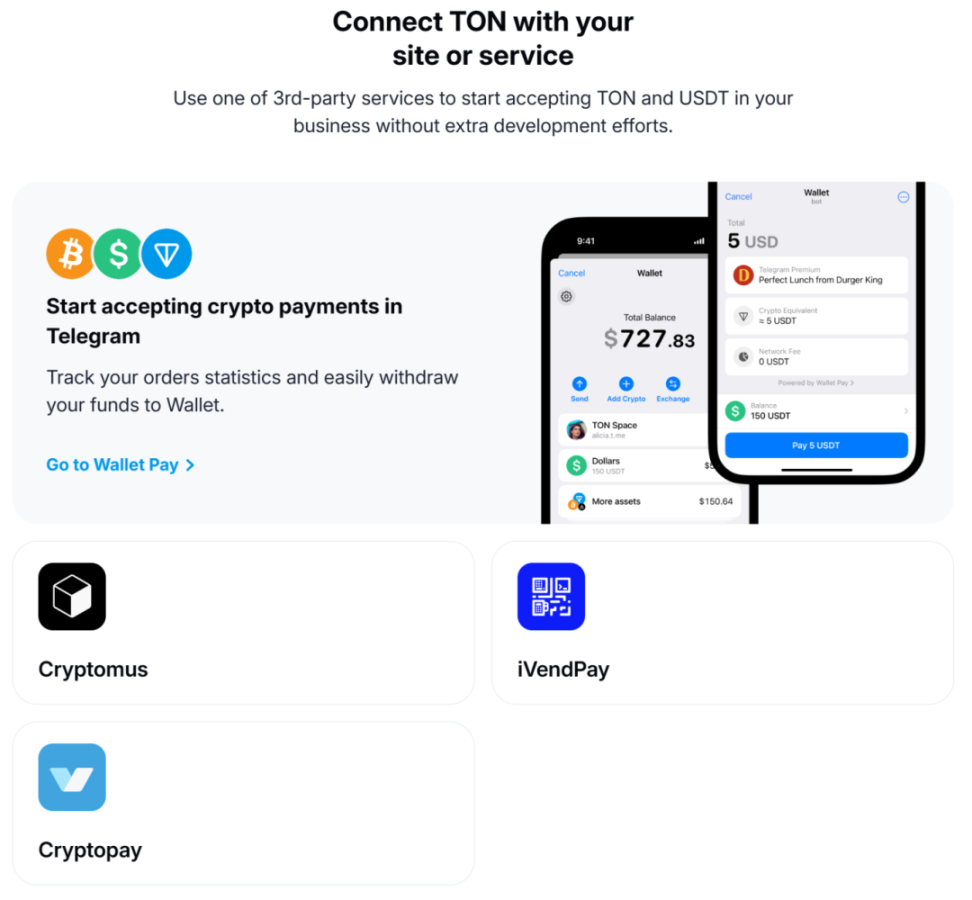Author: Satou
In the field of blockchain, The Open Network (TON) has gradually emerged in the payment track with its unique advantages and deep user base. In 2024, the TON ecosystem has shown strong growth momentum in many aspects. According to the latest data, as of July 21, 2024, the USDT issued on the TON network has exceeded 730 million, becoming an important driving force for the development of TON's payment ecosystem. In addition, TON game platforms such as Notcoin, Hamster Kombat, and Catizen have also achieved significant success, attracting 35 million, 230 million, and 25 million users respectively.
As TON's ecosystem continues to mature and expand, its application prospects in multiple fields such as DeFi, GameFi, and SocialFi are becoming increasingly clear. The CGV research team delves into the "ambition" of TON in the payment track, discussing how it can use its own advantages to overcome challenges and achieve long-term development in the field of cryptocurrency management and DeFi.
TON's Unique Advantages: Backed by Telegram's Large User Base
According to Statista data, as of April 2024, Telegram has 900 million monthly active users, ranking eighth in the global social network list. In comparison, according to token terminal estimates, the public chain with the most monthly active addresses is Solana, with 14 million monthly active addresses, which is less than 2% of Telegram's users.

In terms of user distribution, in addition to Russia and Ukraine, the birthplace of the Telegram software, and the diverse population structure of the United States, Telegram's users are mainly distributed in developing countries in Southeast Asia, Africa, and Latin America.
According to the user profile, Telegram has a large user base, but the average income of users is relatively low, making Telegram more suitable for carrying out business related to traffic, rather than serving high-net-worth individuals.
Compared with other social network projects, Telegram launched its own encrypted public chain very early and tightly integrated the public chain with the social network.
- In 2017, Telegram's founders Pavel Durov and Nikolai Durov began developing a blockchain project called Telegram Open Network (TON) and planned to launch its native cryptocurrency Gram.
- In 2018, they raised about $1.7 billion through an ICO, but also attracted the attention of the U.S. Securities and Exchange Commission (SEC).
- In 2020, due to regulatory issues, Telegram announced its withdrawal from the TON project, returning the development work to the community, which was taken over by the TON Foundation. The project was renamed "The Open Network" and the token name was changed to Toncoin, and the ICO funds were refunded.
After several twists and turns, in 2023, the Telegram official announced that the TON blockchain would be the preferred infrastructure for its Web3, and planned to integrate it into the Telegram App interface. In contrast, Facebook's launch of the Libra (Diem) cryptocurrency network, after various setbacks and regulatory pressures over two and a half years, announced that it would not be launched.
In addition, Telegram's privacy protection and unregulated characteristics make it more friendly to cryptocurrencies, and to some extent, it also carries out gray industries that cannot pass regulatory scrutiny. These gray industries were the widespread application scenarios of cryptocurrencies in the early days, so Telegram carries a large number of cryptocurrency users.
Overall, the TON ecosystem, with the help of Telegram, has had the first-mover advantage in developing cryptocurrencies from the beginning.
How to Monetize Traffic: Overview of TON's Small Game Status
Compared with the "Fully Onchain Game" that was once popular on Ethereum, the recent explosion on TON is likely to be the "Fully Offchain Game," some casual (even slightly juvenile) small games that attract users through economic incentives. The "Fully Onchain Game" on Ethereum adopts a grand narrative of an autonomous world, attracting users through potential cultural identity, but often fails to attract a large number of users. The small games on TON are more pure, just open your phone, click a few times on the screen, and then you can earn 1 point, which can be exchanged for tokens with real value in the future.
Recently, the explosion of TON game projects seems to show the unlimited potential of the industry.
- Notcoin has a very simple gameplay, earning coins by clicking on the phone screen, and the coins are eventually exchanged for Notcoin tokens. It has attracted over 35 million game users and was first listed on Binance and OKX. After listing, the coin price has been rising, with a peak market value of nearly 3 billion.
- Hamster Kombat also uses the Tap to Earn model, and in addition, it provides ways for players to earn rewards through purchasing/synthesizing cards, daily check-ins, social media tasks, and referrals. It has gained over 230 million registered users in less than four months.
- Catizen is a casual cat-raising game that directly establishes cash flow through game monetization and airdrops, with over $10 million in revenue and over 25 million players, and has converted 1.4 million on-chain users.
Notcoin has opened up the imagination of the track, while Hamster Kombat has taken the lead in traffic, and Catizen is more refined and sustainable, representing the future direction: it is not just about clicking, but needs to establish a cash flywheel from day one.
On the one hand, the simple game design allows more users to participate in the game and achieve better user data. On the other hand, due to the simplicity of the game design, the cost of brushing traffic is low, and there may be a large amount of water in the data.
In the future, the small game projects in the TON ecosystem will inevitably need to shift from competing for simple user traffic to competing for the conversion rate of user traffic, which not only requires better game design, but also needs to obtain sustainable cash flow through a clever monetization system to maintain the ability for sustainable development.
Peeking into the Development Focus from Official Channels
According to the TON official website, Mini Apps, GameFi, and DeFi are the types of products that the official wants to onboard.

In the TON Foundation's Grants program, it is also explicitly mentioned to support these categories, and examples of products for each category are given. The key statements are excerpted below.
Telegram Mini Apps: Social Web3 Use Cases
- SocialFi: Creator economy
- E-commerce: Trading markets for electronic or physical goods
- Utility: Daily tools embedded with Web3 elements
- Community & Brand management: Tools for managing Telegram communities
- Onboarding platforms: Bringing new users to @wallet or subcustodial TON wallets with simple scenarios
DeFi
- Lending protocols
- Derivatives DEXs
- DEXs with weighted pools (like Balancer.fi)
- Yield aggregators
- Liquidity layers
- Restaking
GameFi
We are always happy to support web3 games with easy onboarding, viral social mechanics, referral programs, elements of competition (squads, leaderboards, group challenges) and exciting gameplay.
According to the above content, the Social Web3 use cases supported by the Mini App built into TG will be the focus of development; for DeFi, the TON ecosystem hopes to enrich the application types of the DeFi ecosystem; for GameFi, the TON ecosystem can help games with user onboarding, viral social spread, invitation system, and competitive social gameplay.
Predicting the Near Future, the Pros and Cons of the TON Ecosystem
Why [Temporarily] Not DeFi
A key indicator of whether the DeFi track is erupting is TVL. From the current data of public chains, Ethereum is far ahead, with a DeFi TVL of 60 billion, surpassing the total DeFi TVL of all other public chains. One reason is the high value of Ethereum's native asset ETH, which has led to a surge in DeFi TVL. Another reason is the completeness of the DeFi ecosystem on Ethereum, where almost all DeFi innovations occur. Ethereum has also introduced a large amount of wBTC through Wrapped Token, which supplements DeFi liquidity. Finally, Ethereum's introduction of staking and restaking mechanisms has led to the issuance of a large amount of LST/LRT, creating a large TVL.
For TON, the largest asset on the chain is Toncoin, with a market value of about 17.5 billion, and the second largest asset should be the USDT authorized by Tether, which exceeded 730 million on July 21, ranking fifth among all blockchains. According to DefiLlama's data, the current TVL of the TON ecosystem is 757 million, showing a significant shortfall.
In the view of the CGV Research team, the outbreak of DeFi in the TON ecosystem still lacks the following conditions:
- Onboarding of assets such as BTC and ETH: The assets with the largest trading volume in CEX are usually BTC and ETH, high-market-value blue-chip assets. Therefore, it is necessary to rely on high-security, low-slippage, and low-cost BTC and ETH asset cross-chain bridges to introduce a large amount of BTC and ETH into the TON ecosystem, while the current cross-chain bridge infrastructure on TON is still under construction.
- More diverse liquidity staking products: TON has transitioned from PoW to PoS, and the initial supply allocation was given to miners and the team. This has resulted in the choice to reward PoS miners at a rate of 0.6% per year after the transition to PoS. With less than 10% staking rate, TON's staking rate is not high compared to other PoS public chains, so it needs to introduce more liquidity staking products to increase the staking level, enhance the chain's security, and increase TVL.
- More secure wallet infrastructure: The @wallet wallet built into Telegram is a custodial wallet, and combined with Telegram's unregulated nature, large holders often do not trust the security of TON. TON needs to introduce more secure wallet infrastructure, including MPC wallets, and undergo thorough audits to gain the trust of high-net-worth users in TON's security.
And these conditions are not related to Telegram's biggest advantage—user traffic, which is equivalent to giving up its biggest moat, possibly resulting in half the effort for half the result.
Why it is Payment
Native USDT is being issued on the TON network at an extremely high growth rate. As mentioned earlier, as of July 21, 730 million USDT had been issued. Currently, the chain with the most USDT issuance is Tron, with TRC20-USDT issuance exceeding 60 billion. From Tron's data, we can see the huge potential of stablecoin payments.
The TRON network has over 235 million users, with a transaction volume exceeding 7.8 billion, generating annual fees (network fees) of 450 million USD. On average, 2-3 million user accounts transfer over 10 billion USD per day. Most USDT holders on TRON are "retail" or small holders. There are 52.6 million holders with balances below 1,000 USD, and this number is still growing, even during the bear market in 2022. In contrast, the $1K-$10K group has 359,000 holders.
From on-chain activity, most of Tron's on-chain transactions are USDT transfers, with low adoption of DeFi and almost no NFTs. Other public chains' hot LST/LRT and Memecoin are non-existent, yet they still support a transaction volume of 78 billion. It can be said that Tron is a public chain born for stablecoin payments.
The reason why Tron can achieve such a large-scale adoption of stablecoin payments is:
- Tron network's transaction fees are lower than Ethereum, with faster speed and higher TPS.
- Early adoption has led to a network effect, creating a two-way flywheel between users and merchants.
- Long-term stable service has gained user trust.
Compared to Tron, TON's payment business has the following advantages:
- Higher TPS: After enabling sharding, it can support a maximum TPS in the millions, with lower fees than TON.
- Closer to users: The TON wallet is directly built into Telegram, making it more convenient to use and with richer scenarios, similar to WeChat Pay.
- More diverse on-chain activities: TON has more application scenarios for on-chain funds, rather than just simple fund transfers.
The TON Foundation is also actively promoting the application of USDT on TON:
- 5 million TON is used to reward the USDT Farming Pool, where depositing USDT can earn up to 50% APY in Toncoin returns.
- On July 1, Tether partnered with Web3 shopping and infrastructure company Uquid, allowing Filipino citizens to use USDT to pay social security funds on TON.
- Transferring USDT on Telegram using the built-in wallet is free and instant, and can be transferred to friends without the need for an address.
- Products such as subscriptions, VPNs, game platforms, and eSIM on Telegram can directly use USDT on TON for payments.
At the same time, payments will also serve as a key primitive to empower the Telegram Mini App, serving various types of Social Web3 Use Cases. For example, the creator economy (SocialFi) requires payments to complete subscription and tipping functions; e-commerce requires payments to complete purchases. More importantly, the Telegram Mini App is expected to become the Web3 version of the AppStore, and the AppStore needs payment functionality to manage paid applications. In the future, Telegram may emulate Apple and charge fees for paid services for applications logging into its AppStore, further diversifying its revenue model.
Currently, TON has integrated with multiple third-party payment service platforms, allowing merchants to accept payments in various ways.

Of course, compared to WeChat Pay, the payment business in the TON ecosystem still has its risks. The most critical of these is that Telegram's privacy protection and unregulated nature may prevent a large number of physical businesses from accessing TON payments due to compliance factors. However, the TON Foundation is actively seeking countermeasures, one of which is reflected in the requirement for KYC in TON's USDT Farming Pool to receive rewards, from which we can infer TON's attitude towards compliance.
In summary, the CGV Research team believes that TON's rise in the payment track is not accidental, but the result of the combined effect of its strong user base, technological advantages, and ecosystem strategy. Although it currently faces many challenges, such as regulatory issues and user trust, TON has demonstrated strong growth potential with its innovative payment solutions and ecosystem closely integrated with Telegram.
In the future, with the landing of more high-quality applications and the conversion of user traffic, TON is expected to occupy a place in the global payment market and become an important force in the blockchain payment field.
免责声明:本文章仅代表作者个人观点,不代表本平台的立场和观点。本文章仅供信息分享,不构成对任何人的任何投资建议。用户与作者之间的任何争议,与本平台无关。如网页中刊载的文章或图片涉及侵权,请提供相关的权利证明和身份证明发送邮件到support@aicoin.com,本平台相关工作人员将会进行核查。




